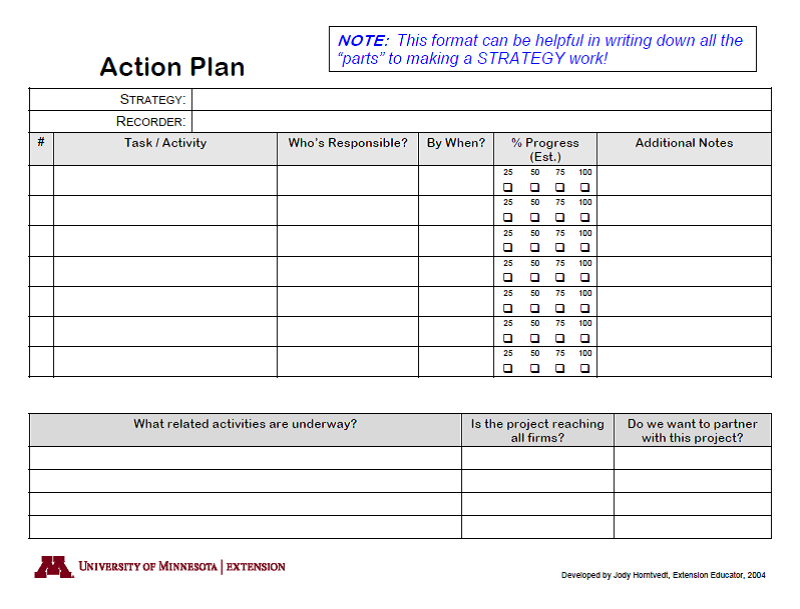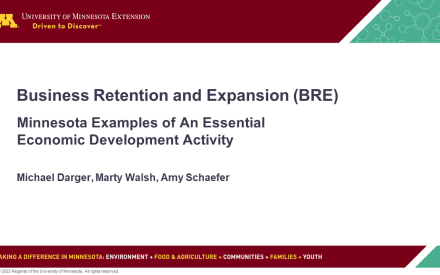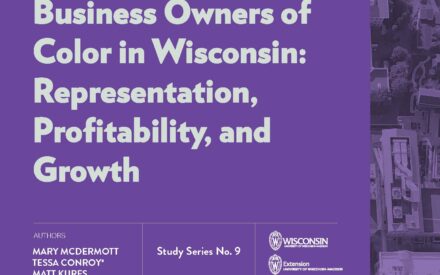
March 2022 — Organizing business retention and expansion (BRE) activities is a common application of or prelude to market analysis findings. These activities include mobilizing a BRE team, identifying issues, and helping existing businesses expand or, if they are at risk of closing or relocating, stay open and stay downtown. Too often, the sudden closing of a long-time business surprises residents and local officials alike who assume a business is doing fine simply because the doors remain open each day. Instead, inquiring with business owners about business challenges and future plans offers clues about possible future actions. Through the market analysis process, and the business survey in particular (see Business Survey section of the Toolbox), you have the opportunity to identify individual business needs you can act to fill, such as providing more space, addressing financing issues, or providing information resources.
Retaining and expanding existing businesses is a common economic development strategy because this is typically less costly and time intensive than recruiting new businesses. As such, BRE is the very practical activity of dealing with businesses and organizations you can see, instead of the nebulous goal of attracting those you can’t see. The success of existing businesses provides proof of the economic viability of a district. Furthermore, businesses content with their community become ambassadors to existing and new entrepreneurs.
Market analysis data can be used in the following four steps of a business retention and expansion strategy:
- Forming a business retention and expansion team,
- Identifying warning flags,
- Offering individual business assistance, and
- Developing business retention and expansion strategies.
Step 1: Establish a Business Retention and Expansion Team
A Business Retention and Expansion (BRE) team coordinates responses to individual business concerns, or warning flags (see Step 2), and develops strategies to improve the local business climate.
The committee should include four or five individuals with the skills and abilities to help businesses with common business challenges like marketing, accounting, or finance, as well as regulatory issues. City officials or economic development professionals commonly join BR&E teams since their role includes connecting businesses to state and local programs and acting as liaison between business and government departments. The credibility of team members and their rapport with the business community is critical. Businesses need to trust team members to handle issues competently and confidentially or efforts to improve the business district will falter.
Market analysis data that has been assembled can be used by the BR&E team to help existing businesses make more informed day-to-day operating decisions. These decisions can relate to inventory, merchandising, advertising and other topics. In addition, data can be used to help make decisions related to location and business expansion. The following information is particularly useful in business retention efforts:
- Characteristics of the business district;
- Description of the trade area;
- Characteristics of existing and potential customers; and
- Trends and future opportunities.
Members of the team should be given a copy of the market analysis. Supplemental information such as detailed demographic reports, lifestyle segmentation profiles, and consumer survey data should also be made available.
Step 2: Identify Warning Flags
Warning flags or “red flags” are issues of individual businesses that are a cause for concern and targets of response from the BR&E team. The primary source of information to identify warning flags is the Business Survey, which includes many questions to identify potential problems.
On the Standardized Business Owners Survey, the needs and opportunities section includes a range of questions to identify warning flags. For example, some questions address important warning flags related to moving or expanding a business:
- “How Satisfied are you with the present location of your business?”
- “Do you have plans to expand or reduce operations for your business in the foreseeable future?
Other questions in the standardized survey ask business owners about their interest in receiving information resources and business incentive programs, and about challenges they face. The survey also asks business owners to rate community assets. For example, a business may cite restrictive regulations as a major challenge. The BRE team would identify this answer as a warning flag and follow up on details to determine if it could help by modifying or waiving an ordinance or zoning codes.
A good process to identify warning flags includes setting aside a time in which the whole BRE team can assess surveys together and discuss appropriate follow up. The team can use the warning flags worksheet to organize its thoughts and keep good records to facilitate a timely response. A good practice is to have two team members review each survey. A viewing by a second set of eyes may uncover issues the first team member did not notice.
The worksheet contains two important columns: (1) level of urgency and (2) organization or person responsible for follow up. Certainly not all warning flags have the same level of urgency. A business indicating plans to move to another community in the next six months is clearly an urgent matter in need of immediate attention, whereas interest in historic preservation tax credits may not be as pressing. The worksheet refers to red and green flags to rate the urgency–standard language in a BRE program. When considering proper follow up to warning flags, the BRE team should not limit itself to its own members’ skills and abilities, but look to other organizations or people who can best assist with the issue at hand. The best people or organizations to handle follow-up are those who can retain the trust and confidentiality of the business owner and are reliable in doing the follow-up. Be sure to notify businesses of your intentions to hand off some issues to appropriate resource people or organizations. Of course, it is important to follow up on the disposition of the warning flag issues. Appointing a warning flag coordinator to ensure that each issue is resolved builds trust and confidence among your businesses.
Step 3: Offer Individual Business Assistance
A starting point for any BR&E team offering assistance to individual businesses is getting the market analysis data into their hands, and then helping them apply the information to their operations. Based on responses to the business survey, the BR&E team will know the particular needs of individual businesses and can use the market analysis data as a guide. Some businesses may be particularly interested in the customer survey findings for marketing or inventory purposes, whereas others keen on expansion may decide the findings on the retail and service opportunities most helpful. It’s important for the BR&E team to determine the appropriate level of contact to best assist businesses. Simply mailing out market analysis results would not have the same impact as a member of the BR&E team sitting down with business management and discussing possible applications. Some uses of the market data include:
- Redesigning marketing plan to attract more customers;
- Opening a complementary new business;
- Motivating existing customers to spend more money;
- Identifying new markets for current product lines;
- Adding new product lines or services to capture a wider market range;
- Opening boutique shops with niche product lines inside other businesses;
- Identifying and adapting to business and marketing trends;
- Repositioning and differentiating the business by changing its image and product mix;
- Expanding existing space or relocating within the district; and
- Opening under one-ownership companion shops that support each other.
Beyond applying market analysis data to business decisions, other areas of assistance may include:
- Store presentation and window display;
- Succession planning and business transition;
- Merchandise presentation;
- Merchandise selection;
- Locating buying groups;
- Customer service;
- Developing/updating business plans;
- Accounting and record keeping;
- Compliance with local, state and federal regulations;
- Inventory control;
- Computer use;
- Website development;
- eBusiness strategy and training;
- Personnel management and training;
- Financial incentives;
- Local code enforcement and public policy;
- Improving advertising and promotion; and
- Identifying and capturing new markets and planning for business expansion.
A warning flag that deserves special and prompt attention is any business owner who plans to sell, close or retire. The BR&E team’s role here could include:
- Serving as a liaison between the business owner and potential buyers or brokers;
- Identifying potential buyers;
- Developing a financial incentive package;
- Helping set up employee ownership (selling to a key employee or conversion to a worker cooperative);
- Providing information and resources on succession planning;
- Helping business owners prepare marketing materials; and
- Working with media on advertising and public relations during the transition.
When following up with individual businesses, the BR&E team may assist as members’ time and skills allow, but should not be hesitate to reach out to others for help. Local university Extension educators, Small Business Development Center (SBDC) counselors, Main Street program business specialists, SCORE business counselors, chamber of commerce and other public or private small business professionals can provide assistance. Follow-up can take many forms, ranging from a response mail to simple information requests to individual consulting.
Step 4: Develop Business Retention and Expansion Strategies
When reviewing business surveys, you will find some issues that cut across many businesses and call for strategies that will affect the whole business district. Some strategies may be simple, such as hosting group workshops to meet community training needs. Others may be more sophisticated, such as forming cooperative purchasing alliances or launching group advertising initiatives. The key is to develop strategies consistent with the findings of the market analysis data and business district activities already under way.
Needless to say, experts do not recommend developing business retention and expansion strategies in a vacuum. Instead, the BR&E team should put in place a process that allows businesses and other interested parties to review business survey findings and develop strategies that address issues common to many businesses in the business district. The process must allow participants time to learn about the business survey findings, brainstorm ideas, and prioritize and choose strategies. This may take the form of a half-day retreat with a facilitator or a couple of smaller meetings. The more people are involved with developing the strategies, the more they will be invested implementing the plan to realize their vision.
An action planning worksheet (see following figure) is a helpful tool the BR&E team can use to implement strategies and move from ideas to action.

About the Toolbox and this Section
The 2022 update of the toolbox marks over two decades of change in our small city downtowns. It is designed to be a resource to help communities work with their Extension educator, consultant, or on their own to collect data, evaluate opportunities, and develop strategies to become a stronger economic and social center. It is a teaching tool to help build local capacity to make more informed decisions.
This free online resource has been developed and updated by over 100 university educators and graduate students from the University of Wisconsin – Madison, Division of Extension, the University of Minnesota Extension, the Ohio State University Extension, and Michigan State University – Extension. Other downtown and community development professionals have also contributed to its content.
The toolbox is aligned with the principles of the National Main Street Center. The Wisconsin Main Street Program was a key partner in the development of the initial release of the toolbox. One of the purposes of the toolbox has been to expand the examination of downtowns by involving university educators and researchers from a broad variety of perspectives.
The current contributors to each section are identified by name and email at the beginning of each section. For more information or to discuss a particular topic, contact us.












 Business Retention and Expansion (BRE) – Minnesota Examples of An Essential Economic Development Activity
Business Retention and Expansion (BRE) – Minnesota Examples of An Essential Economic Development Activity Supporting Business Succession & Transition: Lessons Learned from Minnesota
Supporting Business Succession & Transition: Lessons Learned from Minnesota Business Owners of Color in Wisconsin: Representation, Profitability, and Growth
Business Owners of Color in Wisconsin: Representation, Profitability, and Growth Business & Workforce Development: Clean Energy Funding Series
Business & Workforce Development: Clean Energy Funding Series


